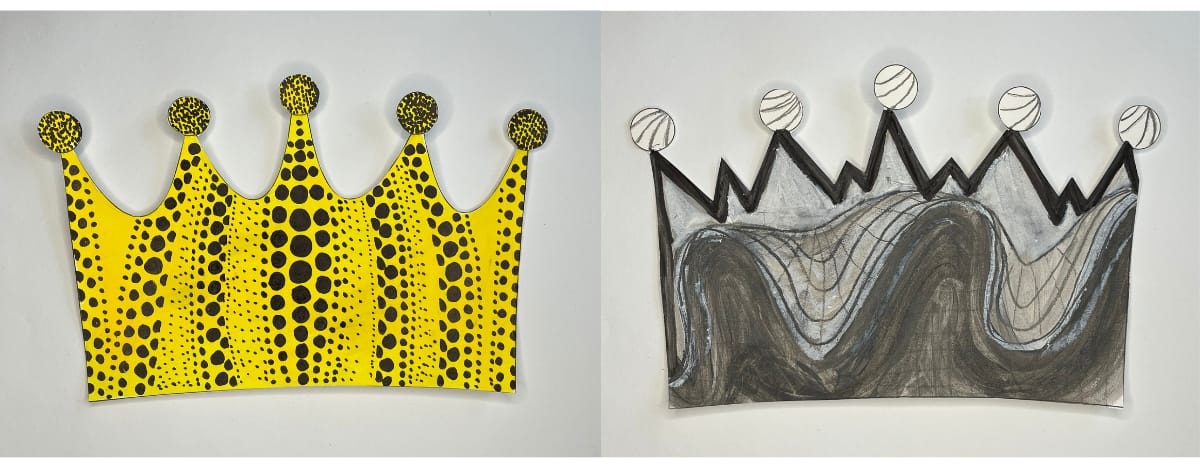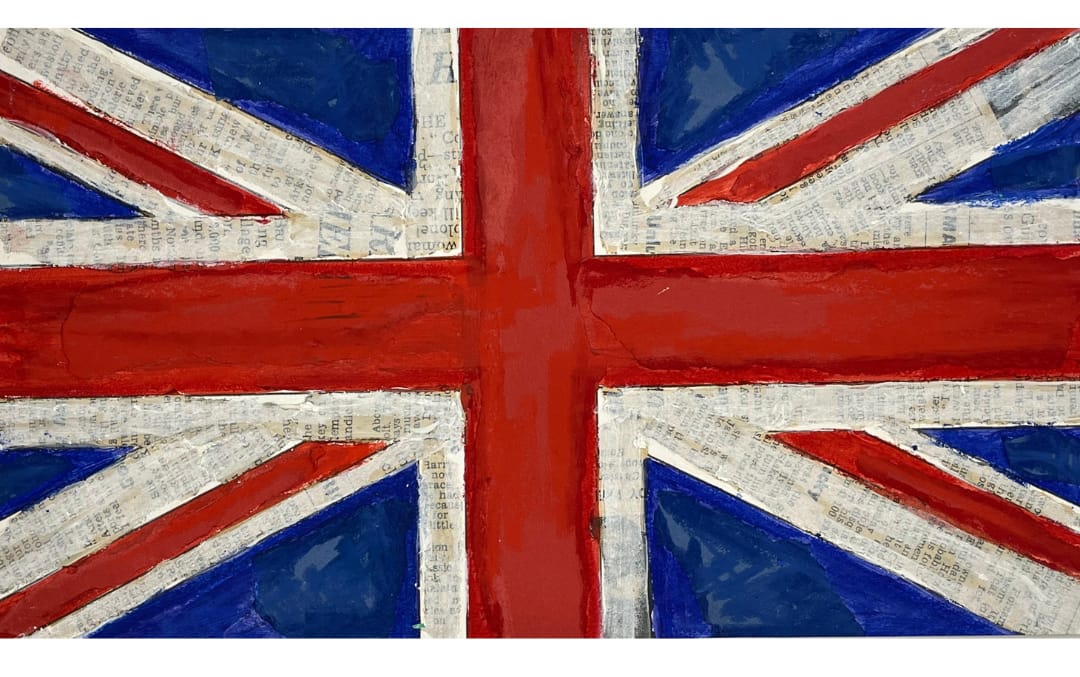A coronation of a king or queen is a unique national event. Mark this important historical moment with our collection of fun and inspiring Art and design projects that can be part of your school and community celebrations.
This blog contains ideas to inspire you to get creative with your class within three overarching ‘royal’ themes: crowns, portraits and flags. Each idea is suitable for any year group, but consider whether you need to make any adaptations to suit the needs of your particular class.
You can follow the suggestions exactly as they are or, if you are inspired by the various ideas, combine them. For example, you like the idea of creating flags but want to use the artists provided in the portrait theme for the designs.
Crowns
Idea 1: What would a crown look like for a famous artist?
- Choose an artist to explore as a class, or allow the pupils to pick one from a selection you provide, for example, Frida Kahlo, Barbara Hepworth, Alberto Giacometti, Giuseppe Arcimboldo or Yayoi Kusama.
- Alternatively, use an artist the children have encountered within the Kapow Art and design scheme, which could be someone like Zaha Hadid, Friedensreich Hundertwasser, Cecilia Vicuña, Romare Bearden or Georgia O’Keeffe.
- If the pupils are unfamiliar with their artist, include some time for research. Sketchbooks can be used to collect information and sketch ideas.
- Ask the children: What would a crown look like for your artist or designer?
You can use an example: Arcimboldo’s crown might feature fruit and vegetables as jewels; Kusama’s crown might be covered with spots!
- Depending on the materials you want the children to use, they can create their design directly onto a flat or wearable crown template or try out their ideas in sketchbooks first.

Idea 2: The King’s crown
- Explain that the King needs a new crown for his coronation and wants it to be personal and reflect his life, passions and hobbies.
- Allow some time to research the King as a class or independently – what he likes and enjoys doing. The pupils may discover his passion for horticulture; his favourite flowers are delphiniums. Or perhaps find out about his work to help the environment and sustainability, or even learn about his passion for architecture.
- Children can create artwork reflecting what they have learned about the King by drawing or painting directly onto a flat or wearable crown template or alternatively making pieces of artwork that can be attached to a crown. They may concentrate on one idea, such as a floral design, or encompass multiple ideas.

Portraits
Idea 1: Modern art – royal portraits.
- Many artists painted the Queen during her long life. You could start by looking at the many different portraits produced of the Queen and explore the vast range of styles artists used to paint her.
- Focus on one of the following portraits: (links for teacher reference)
Queen Elizabeth II (1985) by Andy Warhol.
The Queen (2022) by Oluwole Omofemi
Barack Hussein Obama (2018) by Kehinde Wiley
- Encourage the children to think about how they were made and why the artist might have chosen to represent their subject by discussing them as a class or in groups.
- Provide the children with an image of King Charles to draw from. If needed, the children can use their sketchbooks to have a go at drawing him.
- Ask the children to create a new portrait of the King in one of these modern art styles.
- Here are some ways you could recreate a new portrait of the King using these fabulous artworks as inspiration:
Queen Elizabeth II (1985) by Andy Warhol.
Create a background first. Use a combination of painting in one colour and layering squares of coloured tissue paper over the top to make bold squares.
Use photocopies of a photo of the King and cut it out around his head and shoulders. Either paint or cut out paper to lay over sections of his clothing to change the colours.
Use felt tip pens to draw over the top of the features and outlines of the photograph.

The Queen (2022) by Oluwole Omofemi
Decide on a colour for the background, using paint or coloured paper. Make sure it is bold!
Cut out a colour photocopy of a photo of the King.
Change his outfit by painting over the top (acrylic paints will be thicker and bolder in colour) or by cutting out paper to stick over it. This paper could be patterned or drawn with new designs.
Cut out images of objects from a magazine, or draw some for him to hold in his hand. Think about what these objects could be – perhaps something he likes, such as flowers or something symbolic.
Barack Hussein Obama (2018) by Kehinde Wiley
Kehinde uses floral designs as a background for his portraits. Create a background by using patterned papers such as wallpaper, or by using a combination of painting and images of flowers cut from magazines. See if you can find flowers that the King likes!
Separately, draw a portrait of the King. The pupils could be given free rein on the materials and style they want to use for this. Once completed, cut out and mount on top of their backgrounds.

Idea 2: Our Royal Self-Portraits
- Imagining yourself as a royal is a fun way to create art. Take the basic idea of using a self-portrait drawing or a photograph of the children and consider how these could be designed with different materials and techniques.
- The artists mentioned earlier in this blog could also be used in the same way, but instead of using the King as the subject, use images of the children. To add that regal look, they could add a crown to their head!
- Why not look at portraits of kings and queens across history and use these as inspiration – the children could use their own faces instead of King Henry VIII’s, for example!
- Or take inspiration from Ancient Egyptian royalty and create a portrait in profile. Photograph each child’s head and shoulders from the side and photocopy them in black and white on A3 paper. The pupils could draw a crown on their heads directly onto the copy using oil pastels. They could even add some royal jewellery!

Idea 1: Jasper Johns’ inspired Union Jacks
- During the coronation celebrations, the Union Jack will be flying in all corners of the country, probably including your school! So why not create some art inspired by our iconic flag?
- Look at Jasper Johns’ art, simply called Flag (1954).
- His painting used newspaper and wax under the paint, creating interesting textures.
- Provide the children with a Union Jack template, and stick torn-up newspaper or other papers in the spaces. (The paper could be red, white and blue.) Paint over the surface, or experiment with other materials.
- This could also work as a collaborative piece. Working as a class or in groups, divide one extra-large flag into pieces so each child can add colour to their style. You should write down which colours are to be used in the spaces to avoid mistakes!
Idea 2: British landmarks or royal symbol flags/bunting
- Flags and bunting are a lovely way to decorate your classroom, hall or outdoor spaces. Create something unique and celebrate all things British!
- Research famous landmarks of the British Isles and generate a list. The children could help with this.
- Give each child a different landmark to draw or paint. They could use their sketchbooks to try their ideas and decide on a composition within the space of a flag or bunting template.
- The children could then draw or paint their design directly onto the flag or create a picture to be cut out and added to pre-cut flags, which could be red, white and blue.
- Anything royal-themed, such as castles, corgis, crowns, carriages and jewels, could be an alternative source of imagery that may be easier to source and draw for younger children.
Please note that this blog post references external websites. We do not have control over their content – please check before showing them to the children.





